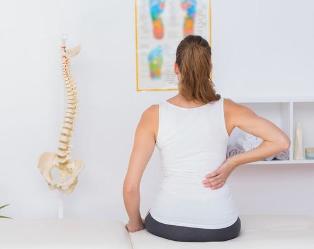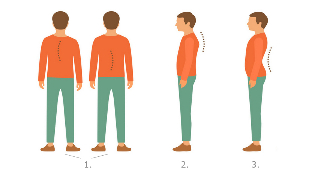Under the correct posture is understood as the ability of a person to keep your body in a straight position at will, without the force of the whole muscle. Each one of us and sits in a certain position, the adoption, which occurs by force of habit. Then, as the direct, physiological is this position, and that determines the degree of "regularity" posture.

The main formation of posture occurs in childhood, but this does not mean that the adult man can't fix your posture, get rid of the disruption and to achieve the correct position of the body. In addition, "spoil" the posture can be the age of adulthood: for example, when the sedentary work and small roll lifestyle. Curvature of the spine may cause painful sensations and diseases, as well as become the cause of deterioration of the appearance of a person.
The causes and consequences of poor posture
The normal state of the spine has curves physiological in lumbar and thoracic departments. However, these curves may be violated, reinforced, smoothed out.
The main causes of such problems include the following:
- the lesions;
- uncomfortable desks and too heavy backpacks in the period in the school;
- the fall in childhood, which resulted in the obtaining of small value injuries;
- incorrect gait and posture in childhood, that we do not control and had not noticed the parents/teachers;
- small physical activity, which caused the weakening of the muscular corset;
- long retention period incorrect posture (most commonly to the fulfillment of job duties);
- it is inconvenient, without success chosen clothing and footwear, taking the position of the body;
- neoplastic, infectious, and other diseases, сказывающиеся in the state of the spinal column;
- a variety of injuries.
Consequences of poor posture can be divided into several types:
- Scoliosis – curvature of the lateral side of the vertebral column, measurable in the frontal plane.
- Kyphosis – curvature of the spine in the chest in the direction of behind on a sagittal plane.
- Lordosis – curvature of the spine in the lumbar region to the front in the sagittal plane.

As has already been noted, problems with the posture, often take root in childhood. And not the least to be played in school and backpacks, which are children forced to use every day. The doctors found out that, to carry the wallet has no impact on the state of the spinal column of the child, its weight should be no more than 10-15% of the weight of the baby.
In addition, disturbances of the posture, often cause дегенеративно-дистрофические diseases that lead to restriction of mobility, painful feel, and even interruptions of the entire musculoskeletal system. This is osteocondrose, osteoarthrosis, as well as between the vertebrate animals грыжах.
If you talk about the aesthetic consequences of the poor posture, one can notice a lean silhouette, concave on the inside of the chest, convex, and the joy of a visual more voluminous abdomen, and a number of other unpleasant changes in the appearance of a person.
What should be the correct posture
Check how correct you posture, quite simple. Lean back to the wall, back to back and note the position of the heels, calves, buttocks, shoulders and the nape of the neck. All of these parts of the body have come into contact with the wall, and you don't have to put effort to stretch the muscles to achieve this effect. Otherwise, you can talk about what you have violation of posture.
More a simple test is to ask someone to do your shot in the back. Then, in a photo taken direct pass characteristics in three lines: the ankles, the pelvis and shoulders. These three features should be parallel to each other, otherwise, you can talk about the presence of contorcionismo.
The main highlight is correct, it is physiologically correct posture can be attributed to the following:
- A smart look, smooth belly. Of course, the appearance of the belly depends on the physical of a person, however, the correct posture always make us visually more well-formed in this area.
- A small protuberance in the region of the chest. It's not worth doing "chest runs", or, on the contrary, the flatness of the back, as if she is nailed to the board. Correct posture necessarily includes the small natural curves of the spine.
- The vertical position of the head.
- Reserved for the back, and a little of that was put down from the shoulders. It's not worth to take the blades or very shrink the shoulders, as well as, again, it is not natural for our spine.
- A slight bend of the knees, light, "flying" of the march.
The use of the correct posture
- improvement of the functioning of many internal organs and systems and, as a consequence, the improvement of the general well-being;
- removing the discomfort, pains in the upper part of the body (back, shoulders, neck);
- prevention of scoliosis, osteoporosis, and other diseases that make the person unattractive and detrimental to their health;
- to avoid the formation of so-called "beer belly", which is not insured even the people of easy sizes;
- to improve mental performance, concentration ability;
- increased self-esteem, the formation of a healthy self-confidence, which is so necessary to achieve the objectives.
A great enemy of correct posture is high-heeled shoes. The walk in such shoes, inevitably, causes a change of inclination of the body, which leads to violation of posture and even to the emergence of a systematic pain in the lower back. And the representatives of the fair sex, who regularly walk in high heels, can, over time and not win the hernia of the intervertebral disc.
Simple exercises to maintain posture
As has already been noted, poor posture – it is not a pity, even for an adult. It is quite possible to adjust, and internally, using the most simple and intuitive exercise. They are ideal for those that have deviations from the correct position of the vertebral column, has not yet turned into serious chronic diseases, such as scoliosis. Otherwise, improve posture it is also possible, but already in the framework of the special healing complex.
The starting position for the first group of exercises – the same that to verify the correction of the posture. Lean back to the wall so that your heels, calves, buttocks, shoulders and the back of the head, at the same time, his touched (for a person with a disability the attitude of maintaining such position requires muscular effort).
By taking this position, perform the following steps:
- Simply hold the posture for three to five minutes.
- Keeping all the above listed point of contact of your body with your back, alternately lift your legs, bending your knees. Perform this exercise 10 times for each leg.
- Make a queue of the bend to the right and to the left (10 times in each direction), taking care not to overflow the contact of the heels, calves, buttocks, shoulders and the nape of the neck with the wall.
- Приседайте on the wall, keeping all of the superiors of the point of contact of the body with the wall. In other words, you have a kind of "sliding" down a wall, and then, in the same way, the survey. 10 repetitions of these exercises will be enough.
A good way to correct your posture is the diving. When a person is in the water, the gravity of the load in your spine are significantly reduced. Thanks to this, it strengthens the muscular structure of the spine, improves the tone near the muscles of the spine, as well as the muscles of the waist and chest. All this has a beneficial effect on the posture.
If you are serious about substantial improve posture, want to also do muscle-strengthening steel frame.
To do so, are suitable the following exercises:
- normal push-ups from the ground;
- the preservation of the posture of the "plank" for 30-60 seconds (under the "strap" refers to the retention of the body in a straight position when very only in socks and forearm);
- exercise "лодочка" (lifting simultaneously both hands and both feet from a position lying on the stomach);
- the retention of the dumbbell in the raised and direct the hands to the level of the shoulders (exercise is carried out in a seated position, keeping the dumbbell has a 5 to 7 seconds for a lift).

























